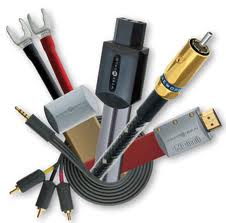 It’s time for the cabling industry to reassess how it approaches marketing to consumers.
It’s time for the cabling industry to reassess how it approaches marketing to consumers.
I find Twitter entertaining and, at times, almost addicting. This morning a tweet from Production Advice’s Ian Shepherd shocked me with concern for an electronics category that I think is beneficial: cabling.
Shepherd retweeted a blog written by L.A. recording engineer Bobby Owsinski, who blogged about a 2008 Engadget story that asked 12 “audiophiles” to compare an audiophile cable brand with another cabling product. It turns out the other cabling product was a set of coat hangers. The crux of the story is that those audiophiles couldn’t tell the difference between coat hangers and expensive cables.
Adding insult to injury, Owsinski points out the obvious difference between the audiophile community and professional sound engineers that use their listening skills for work by noting, “‘audiophiles’ showed just why they get so much abuse from pros over their so-called “golden ears.”
Monster was the cable manufacturer in question in Engadget’s blind testing, and Owsinski says Monster does make good products; the problem, in his opinion, is with how the products are marketed. “Monster Cable takes some reasonably good cable and markets it in such a way that its perceived value is a lot greater than it deserves to be,” he asserts in his blog. “The problem is that for speaker cable, 12 or 10 gauge zip cord [lamp cable] will work just as well as expensive Monster cable.”
Unfortunately for the cabling industry, Owsinski isn’t alone in his opinion, and websites such as Audioholics.com fuel the public’s disdain for cabling by publishing stories that attack the credibility of many of the cable category’s claims for improved performance.
Like Owsinski, Gene DeSalla at Audioholics points out that Monster and other brands aren’t necessarily bad, its just that their products don’t measure up to the claims.
To rectify this problem, I think it’s time for the cabling category to own up to its self-generated hyperbole and tone it down. Let’s start by addressing the claims of exotic materials, proprietary construction techniques and slick geometry designs that contribute to their out-of-this-world performance claims without any third-party verification.
Manufacturers should look to develop products that are affordable to consumers in these difficult economic times. Too often, critics point to the steep price tags attached to some cabling products and note that a consumer could buy a nice car or place a down payment on a house with the amount of money some companies ask for a pair of speaker cables.
The last thing the cabling industry needs to do is educate the public on the benefits of a properly designed cable that employs quality materials. Owsinski says cabling can make a difference in how a system performs, and I believe he is correct. Using dealers, let’s teach consumers on how to buy cable and how to listen.
One other suggestion I would make is that maybe we should think about locking audiophiles in the basements from which they came. For all their passion about music and equipment, they inflict a lot of irreparable damage to an industry that can hardly afford the scrutiny of a public that doesn’t respect their collective opinions. OK, OK, I’m only kidding about that last suggestion, but I would take away their Diana Krall and Patricia Barber CDs and LPs as punishment for their past transgressions.
By Robert Archer
http://www.cepro.com/article/the_cabling_industry_needs_a_makeover/K536
Custom Installation Services, LLC – ”We may be a few dollars more than the competition, but we are a million times better”.



